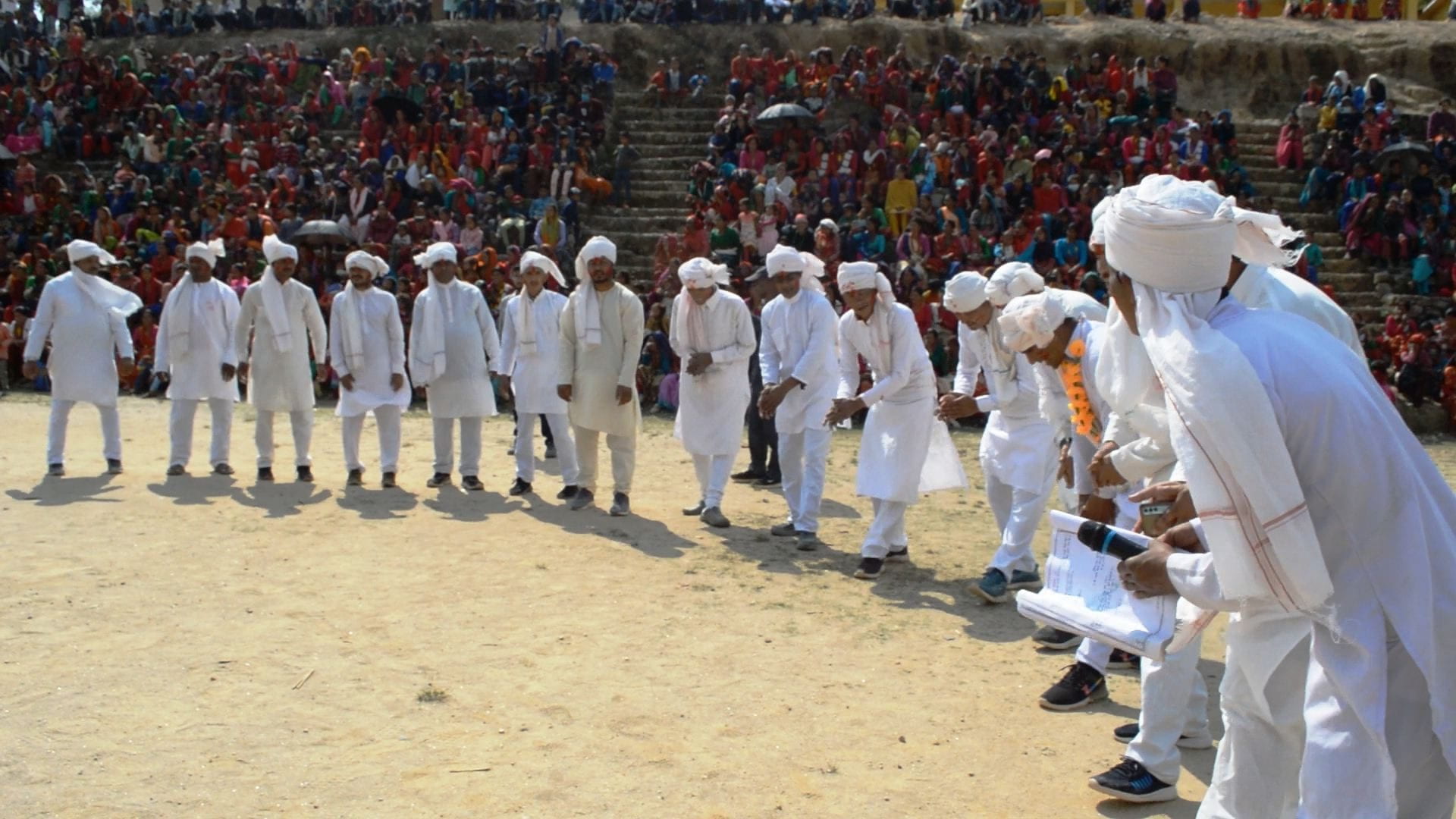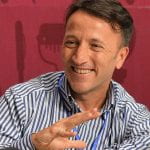Latest posts
- Curricula: Mithila art-focused local curriculum in Nepal 2 July 2025
- Register now: MAP International Online Conference 2025 1 June 2025
- Policy brief: Gira Ingoma book and policy brief: “The Culture We Want, for the Woman We Want” 28 November 2024
- Manuals and toolkits: GENPEACE Children’s Participation Module in the Development Process 13 November 2024
- Journal article: [Working Paper] Gira Ingoma – One Drum per Girl: The culture we want for the woman we want 30 October 2024
- Curricula: Beyond Tradition: Psychosocial Model 30 October 2024
- Curricula: Beyond Tradition Module: Revitalizing Lenong as a Model for Teaching Betawi Arts 30 October 2024
- Curricula: Beyond Tradition: Lenong Revitalisation as a Model for Teaching Betawi Cultural Arts 30 October 2024
- Beyond Tradition Lenong Performance “RAWR…! Kite Kagak Takut” 30 October 2024
- Journal article: [Working Paper] Facing Heaven – Déuda Folklore & Social Transformation in Nepal 30 October 2024
- Curricula: Building Community Curriculums 24 October 2024
- The Magic of Theatre Project Documentary 24 October 2024
Facing Heaven – Dēudā Folklore, Art & Peace in Nepal
1st June 2023
Author
Inception Fieldtrip May 2023
(With contributions & Translation from Dila Dat Pant)
Introduction
Funding from the Arts & Humanities Research Council (AHRC) via a Mobile Arts for Peace (MAP) commissioned project began this April, exploring the role of Nepalese Dēudā culture on local conflict issues, peace building and policies for sustainable peace in society. Dr Simon Dancey of the University for the Creative Arts is the projects Principal Investigator alongside Co-Investigators Nar Bahadur Saud and Dila Dat Pant.
Dēudā or Dēudā Khel is a Nepali genre of song and dance, performed in the Sudurpashchim and Karnali provinces of Nepal, as well as in the Kumaon Division of Uttarakhand state of India. It is performed at various festivals, such as Gaura. The dance is performed by singing Dēudā songs in a circulus by holding each-other’s hands. It is considered as part of the cultural heritage of Karnali Province. The project has a number of specific objectives:
- To explore the ways in which Dēudā culture can be used to promote local peace building in a dialogue between young people, educator and policymaker.
- To assess limitations between local practices and peacebuilding approaches by using arts-based approaches to promote the wellbeing of young people, particularly those from remote and marginalized groups.
- To investigate alternative communication structures and approaches to inform local, national, and international approaches to peacebuilding.
Dr Simon Dancey undertook an inception research visit to Nepal for the setup of the yearlong project this April. The next step of the project will gather primary data vis semi-structured interviews from social actors in Nepal, exploring the research objectives. This research project is an important effort to preserve and understand the Dēudā culture in Nepal, which is an integral part of the country’s cultural heritage. The collaboration between UCA and MAP, along with the support of local co-investigators and the government, demonstrates the importance of international cooperation in understanding intangible cultural heritage.
Background
Nepal is a landlocked country in South Asia and is bordered by China and India, with a population of 29M. It is in the Himalayas and contains eight of the world’s ten highest peaks, including Everest. The Nepalese Civil War was a protracted armed conflict that took place in the former Kingdom of Nepal from 1996 to 2006. It saw countrywide fighting between the Nepalese royal government and the Communist Party of Nepal (Maoist), with the latter making significant use of guerrilla warfare. The government system is now a federal parliamentary republic; the chief of state is the president, and the head of government is the prime minister.
Day 1- 3 Kathmandu
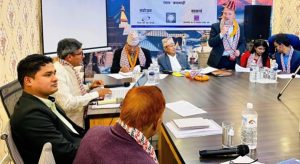
A snap of the Kathmandu Symposium on Deuda. On the left of mine are former Deputy Prime Minister Bhim Rawal and a sitting MP Dayal Bahadur Shahi (Dila Datt Pan)
Flying into Kathmandu, I was both excited and nervous about the upcoming research project. I had travelled extensively in the region (Bangladesh, India, Myanmar, Sri Lanka etc.) but never to Nepal. Friends had waxed lyrical, misty eyed about both its beaty and dangerous terrain. The trip would involve quite a lot of travel inside Nepal and up into the mountainous region in the West. A lovely welcome awaited me at the airport, led by my local Co-I Dila, who I later was to learn had organised a superlative inception programme.
Kathmandu was warm and dusty, and we kicked off the following day with national-level consultation program called Discourse on Dēudā Folklore.
The program brought together artists, scholars, practitioners, and media professionals to explore the topic of discussion, and two academic papers were presented to open avenues for further discussion (see appendix for details).
The passion of the participants was palpable, and speakers regularly broke out into song. It was an honour to be present and hopefully facilitate giving a wider voice and exposure to this area of Nepalese culture. The areas discussed ranged from historical context of the folklore to sociological investigations, semiotics and government policy. As the long meeting progressed, several themes emerged on song content and form. These included:
Gender.
Dēudā is common folklore for all, irrespective of gender, despite existing gender imbalances. For example, women were traditionally sent to Menstrual sheds that are demolished but female segregation still happens. However, in, women in Dēudā play strong empowered role in challenging gender stereotypes and patriarchal power. This was demonstrated in song responses berating ‘lazy, drunk men’. A growth in Aids and HIV outbreaks in the Western region has also been linked to migrant Nepali male works visiting India and returning with infections and this theme also making its way into songs.
Regionalism.
The very different local socio-cultural imaginary of the Western region versus hegemonic dominant national socio-cultural imaginary and the marginalisation of Western cultural forms
Historicity.
Dēudā songs are rich enough in reflecting the annals of a long history. The following piece speaks of how the conflict between the then powerful regime of Sinja State and Khar state took to a fierce battle and how the Sinja squad was fated to suffer destruction:
Tallo bato talchhedoko, majh bato Humliko/
Taulakhar ladain bhaigo, nash padyo Jumliko//
(The lower path is of Talchhedo whereas the middle path of Humli/
A fierce battle took place in Taulakher and Jumli fighters suffered a huge loss//)
Another stone inscription dating back to 1461 BS (900 years ago) offers a deuda song in it (Padam p Kalauni):
Chhakalyaka Bali Raja, sanjhaka Shahi bhaya/
Sinjako Shreepech boki, Chhinasim ai gaya//
(King Bali came in the morn, whereas the Shahi’s arrived in the eve/
Fetching along the Crown of Sinja state, they came to Chhinasim//)
Government.
A critique of both local and national politicians on their failure to deliver of corruption or cronyism. Some folksongs reflect of how the rulers used to exploit the public:
Birkulya Paltan Ayo, Manobhari Rakha/
Bhari boknya Gaulya ho, Palo Suni Rakha//
(The Birkulya batallion has arrived, spare potful of foodgrains for them/
O! the fellow village porters, take into account your turn to serve them//)
Love & Sex.
One of the most dominant themes across folklore ranging from young lovers to couples bringing shame on their village for inappropriate behaviour. Example below:
Boy: Tero Poi Naintaal baijhau, pardeshai marijhau/
Tera Poiko lagnya maya, maitira sarijau. //
(I wish your husband goes to Nainital(india) for work and he dies over there/
And your love to him thereafter gets transferred to me//)
Girl: Ichala ko dabya ghans, budhi gai charali/
Mera Poile ke birayo, teri Joi marali//
(The grass on the upper slope would be grazed by an old cow/
I wonder what wrong my husband has caused to you and curse you that your wife dies instead//)
Form.
The structure of the song has strong link to movement and rhythm of the dance. Many songs are long lived in the societies, and they speak of the fatalism, pain, helplessness, social structures, love and so on.
Former Deputy Prime Minister Bhim Rawal started with a few such classic songs:
Rajpur hai Jangipur, Kanya hai Kachali/
Kya chadhi gulabi ranga, kya maya basali//
(The first segment of journey is from Rajpur to Jangipur and the next from Kanya to Kachali/
You are blushed in rosy cheeks; I wonder if you get in love with me//)
Kasaiki Basmati Dhan, Kasaiki Kode Nai/
Kasaiki sunko har, kasaiki pote nai//
(Some feed in the Baasmati rice while others do not even have millet to eat/
some are so privileged to own the chains of gold while others do not even own the normal bead//)
It is also a tradition that such template-based songs are adapted to local circumstances also e.g., looking for work and consequence thereof.
Ka falu dukhako bhari khutta tutan lagya/
Pradeshi karam mero sath chhutan lagya//
(Where do I put my burdens on, my legs are nearly collapsing/
Fated to be a migrant worker abroad, I am to lose all my companions//)
Dēudā was felt to catch the context of changing society and was part of all festivals except death festival. My thanks for translation of songs and added comments and interpretation on this section from Dila Datt Pant.
Day 4- 5 – Achham & Seti
The following day we took an internal flight to Dhangadi, and home state of Dila. We were travelling with team member Govinda, whose mountain village we would be visiting, a ten-hour drive from Dhangadi airport. The flight allowed a view of the Himalayas, and the panorama was sublime, for a moment it felt like being close to the face of God and Facing Heaven. Back to earth in Dhangadi the temperature was decidedly hotter hovering around 30°C. An encounter with a bevy of Tharu indigenous women, dressed in their traditional attires, at the airport was a solace to forget the heat. With Dila’s support, I took chance to capture a moment with them.
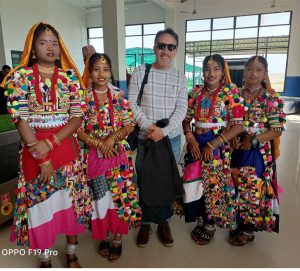
Tharu Indigenous women, encountered in Dhangadhi Airport (Dila Datt Pant)
We climbed into our waiting 4×4 and began the long, winding journey into the mountains with a camera person and local woman journalist.
As I’d been warned, the roads were narrow, serpentine and regularly revealing sheer drops tumbling down into verdant valleys very, very far below. Small shrines and flowers bedecked areas where travellers had not been so lucky and plunged to certain death. My colleagues seemed bemused at my perma-stressed face and white-knuckle gripping of the door handle, untroubled by what I thought was imminent death.
As Conrad showed us all, it’s often the journey that reveals the most, not just the destination. The mountains culture offered some startling juxtapositions, with an increasing arable farming presence, balanced with almost universal mobile phone use.
We stopped at small roadside building for food, the staple of dhal, rice, saag and roti tasting delicious in the mountain air.
We stopped next at a breath-taking mountain Hindu shrine, the view stretching down into the Seti River valley and terraced areas of golden wheat everywhere. Mostly though, there were no men to be seen in the field, the women scything, collecting and husking the wheat. The men we learnt later talking to local women were mostly playing cards and drinking.

Wheat field on the bank of Seti River in Doti
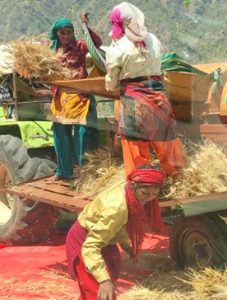
Wheat gathering near Seti River
We eventually began our descent and arrived at Achham, our place for the night, as darkness fell, the sky obsidian, flecked by stars and house lights so high it was impossible to tell which was which.
The next day began with a climb back into the mountains, heading for Govinda’s village. This time it was just single dirt track, dried mud and rock. I tried not to look down. Hours later we reached a dead end and clambered along a small pathway into the village. The welcome I was not expecting and took my breath away. The entire village, bedecked in traditional costumes turned out to welcome us. Flower wreaths speeches and welcome food took up the next few hours. It was very humbling and the people so warm and welcoming.
We them moved to the nearby festival area, one of the very few substantive flat open areas that was growing wheat. The rest of the afternoon was simply breath-taking, my expectations of meeting a few performers were entirely wrong. Dila and Govinda had surprised me with a full scale live Dēudā competition with many other queued up cultural performances that were constituents of Deuda culture. This rural municipality named Mellekh, where the show was held, welcomed over 1,500 participants from surrounding villages and the local government had supported the coordination of the visit. Incredible. The performance was beautiful and complex, giving life to the symposium discussions back in Kathmandu. Musicians, dancers and call and response from the circles of performers, in varying local dress was incredible and illuminating. We had manged a few semi-informal interviews exploring themes and structures, but I was mostly awarded the role of guest of honour, giving speeches and handing out prizes.

Putala Dance: a constituent dance of Deuda folklore performed a school premises in Mellekh.
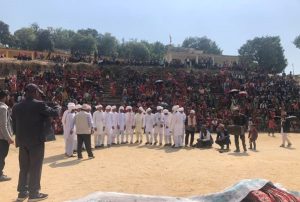
Hori: a folk dance which is performed in the similar movement of Deuda.
It was an exceptional day that ended with being pulled into a Dēudā circle to dance and laugh in the 39°C late afternoon sun and dust, perched on top of a mountain in distant Nepal.
Day 6 – 7 – Dhangadi
It had taken most of the previous day to drive back to Dhangadi. The trip to Achham already feeling dreamlike. Dhangadi itself was part of the plains and it felt strange to be ‘down’. The day began with a beautiful visit to Dila’s family home and family, surrounded by banana plantations and the border with India within a stone’s throw. I was honoured at the warm hospitality and very enthused to meet his father at 96 so passionately sharing some Deuda songs for us.
The afternoon was spent meeting local politicians to discuss the project and finance and TV and radio interviews, talking through what we’d been doing and what our next steps would be.
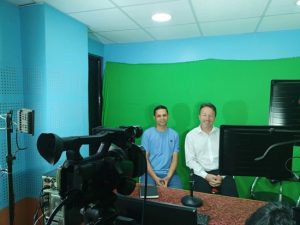
Giving Interview at Dinesh FM in Dhangadhi (Dila Datt Pan)
Day 8 – Kathmandu & London
The final day in Kathmandu involved squeezing in some last-minute sight-seeing and a last-minute wrap up meeting with Dila and Govinda and a lovely gift mug. Pashupatinath Temple was stunning and watching the cremations taking place outside on the tributary of the Ganges left me moved, orange robbed figures wreathed in smoke. It struck me that it’s much better to have death visible like this, than our Western approach of compartmentalising it.
Perhaps, the following excerpt from my friend Dila’s poem best suited to narrate the scene on the Aaryaghat; the bank of Bagmati river in Pashupati.
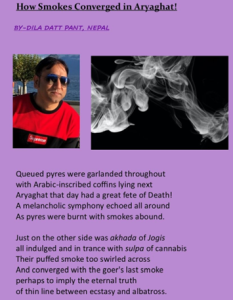
A poem by Dila, who is a co-researcher of my team
And that, alongside many other thoughts and inspirations accompanied on my flight back to London. I’d learnt so much already and couldn’t wait to continue the research and I was already planning my return to the incredible Nepal, that I now realize the Lonely Planet had not simply ranked Nepal as trekker’s paradise!
For further details regarding the project, please refer to the Twitter account of UCAR Office at https://twitter.com/UCAROffice.
Dr Simon Dancy (PI – simon.dancey@uca.ac.uk) & Nar Bdr. Saud (Co- I – 2109573@students.creative.ac.uk) can be contacted for additional information.
All Pictures copywrite ST Dancey 2023 unless otherwise credited
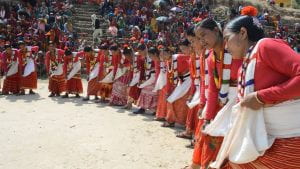
Dēudā Folklore & Social Transformation in Nepal
Exploring how Dēudā song, dance and music can support dialogue in post-conflict settings for peacebuilding advocacy and social cohesion
